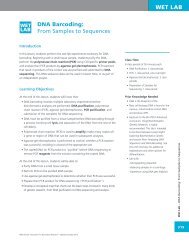LESSON 4 Using Bioinformatics to Analyze Protein Sequences
LESSON 4 Using Bioinformatics to Analyze Protein Sequences
LESSON 4 Using Bioinformatics to Analyze Protein Sequences
Create successful ePaper yourself
Turn your PDF publications into a flip-book with our unique Google optimized e-Paper software.
<strong>LESSON</strong> 4KEY4<strong>Using</strong> <strong>Bioinformatics</strong> Tools <strong>to</strong> <strong>Analyze</strong><strong>Protein</strong> <strong>Sequences</strong> Teacher Answer Key[Note: The suggested <strong>to</strong>tal point value for this worksheet is 20 points, or 2 points per question.]PART I: Translating DNA in<strong>to</strong> <strong>Protein</strong> <strong>Using</strong> ORF Finder9. How many open reading frames contain potential proteins greater than 100 amino acids long?For the majority of sequences, there will be 2-5 open reading frames greater than 100 amino acids.10. Which open reading frame contains the longest potential protein?For the majority of sequences, Frame +1 will contain the longest potential protein, and will encode the COIprotein. For others, Frame +2 or Frame +3 will encode the COI protein.11. What are the base positions of this potential protein?For sequences that contain the longest protein in Frame 1, the first base position will be #1 and the last baseposition will be at approximately base #1540. However, some COI sequences are shorter than 1540 bases.(A) From base #: __________ 1 (B) To base #: __________ 154012. What is the length of this potential reading frame (in nucleotides)?Approximately 1540 bases, though some will be shorter.14. How long is this protein (i.e., how many amino acids)?Approximately 512 amino acids (give or take a few).15. Is the length of the protein similar <strong>to</strong> what you would expect given the length of the DNA sequence in Step #13above? Why or why not? [Note: Remember that each codon for one amino acid is three nucleotides long.]Yes, this should be approximately what students expect:1540 / 3 bases per codon = 513 amino acidsLesson 4 – <strong>Using</strong> <strong>Bioinformatics</strong> <strong>to</strong> <strong>Analyze</strong> <strong>Protein</strong> <strong>Sequences</strong>155©Northwest Association for Biomedical Research—Updated Oc<strong>to</strong>ber 2012
















